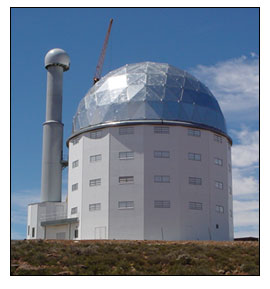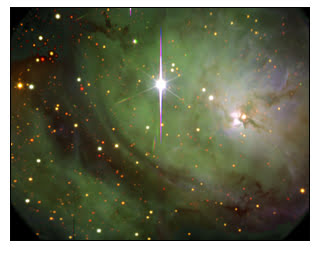CAPE TOWN, South Africa, Nov. 11 -- The Southern Hemisphere's largest single optical telescope -- powerful enough to detect objects as faint as a candle flame on the moon -- was officially inaugurated in a ceremony yesterday attended by approximately 1000 people, including South African President Thabo Mbeki. The Southern African Large Telescope (SALT) took five years to build at a cost of $20 million.

The Southern African Large Telescope, the Southern Hemisphere's largest telescope, as it neared the end of construction earlier this year. (Photo: SALT)
Although similar to the Hobby-Eberly Telescope (HET) in Texas, the builders of SALT were able to learn from design flaws on the HET when they created the new telescope. As a result, SALT has a redesigned optical system using more of the mirror array. It has a 36-ft diameter mirror, comprised of 91 identical spherical hexagonal segments. The telescope is tilted at a fixed angle of 37° from the zenith, so that it moves only in azimuth, rotating into position on air bearings and remaining stationary during each observation. Precise pointing and tracking are handled by the moving optical corrector assembly and instrument payload at the top of the telescope tube. Those involved in the project say SALT is truly representative of the century in which it has been built, since not only is it a sophisticated computer-controlled precision instrument, but it is also an Internet-age telescope. Astronomers in the consortium won't have to travel to SALT to use it. Instead, they will submit their observing requests over the Internet and eventually, once the observations have been conducted by the SALT operations staff, they will also receive their data over the Internet.
With the ability to gather more than 25 times as much light as any existing African telescope, scientists expect it will be able to record distant stars, galaxies and quasars a billion times too faint to be seen with the unaided eye. Some of the questions about the universe that scientists expect SALT to be able to answer include: What was the universe like when the first stars and galaxies were forming? What kind of worlds orbit other suns? How are the stars in nearby galaxies different from those in the solar neighborhood? What can these stars tell us about the scale and age of the universe? and How do quasars and gamma ray bursts outshine trillions of stars like Earth's sun? Scientists also hope to inspire the many schoolchildren expected to visit the telescope to study science.

The Lagoon Nebula, a region 3800 light years from Earth, as seen by SALT and captured by SALTICAM.
SALT is located on a windswept hilltop near the tiny Karoo town of Sutherland, where the lack of "light pollution" makes it one of the best places in the world to observe the night sky. Since the early 1970s the area has been home to the South African Astronomical Observatory's (SAAO) research telescopes, including the 1.9-m telescope, which was considered the largest in Africa before SALT. The new telescope was completed this year with funding from a consortium of international partners from South Africa, the US, Germany, Poland, the United Kingdom and New Zealand. In September, exactly five years after groundbreaking, the SALT project released its first color images, or "first light," marking the successful debut of full operation for SALTICAM, a $600,000 digital camera designed and built for the telescope at the SAAO. SALTICAM is a multi-purpose device that can perform the roles of both an acquisition camera and an imager/photometer, capable of conducting science. It is situated at the prime focus, but fed by a 45° mirror. Fore-optics provide focal reduction (to f/2) to produce a suitable plate scale and allow the entire science and guidance fields to be imaged (i.e. to 5 arcmin radius). Frame transfer, science grade and CCDs with fast readout times allow for science imaging and high-time resolution photometry, opening a new domain in time variability studies on 10-m class telescopes.
Major instrumentation on the SALT also includes the prime-focus imaging spectrograph (designed and built for SALT by the University of Wisconsin-Madison and Rutgers University), which has been renamed the Robert Stobie Spectrograph in honor of past SAAO director and SALT board chairman Robert S. Stobie, who died suddenly in 2002.
For more information, visit: www.salt.ac.za